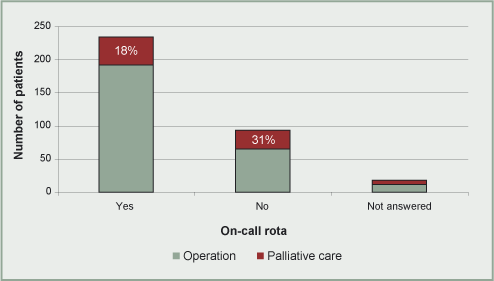On-call rotas
| A greater proportion of emergency patients underwent surgery when treated in a hospital with a vascular surgery on-call rota. |
The relationship was examined between the number of patients for whom the decision was made to operate and the presence of a surgical vascular on-call rota (Figure 4).
Figure 4. Separate on-call rota for vascular surgery by treatment decision in all emergency admission patients n=342
18% (42/231) of patients received palliative care in units where there was an on-call rota for vascular surgery and 31% (29/93) received palliative care in units where there was not an on-call rota (no information about on-call rotas was given for 18 patients). NCEPOD does not know whether these data were affected by hospitals that did not have an on-call rota transferring patients to hospitals that did.
These factors are linked, because membership of the VSGBI and surgical on-call rotas are more likely to be associated with working in a large vascular unit. Data in Table 6 in Organisation of vascular services show that the outcome of surgery after emergency admission was slightly better at large vascular units. Is it possible that there were some patients who received palliative care who might have undergone surgery if they had been admitted to a larger hospital or had come under the care of a surgeon with a greater involvement with vascular surgery?
Back to top
|

